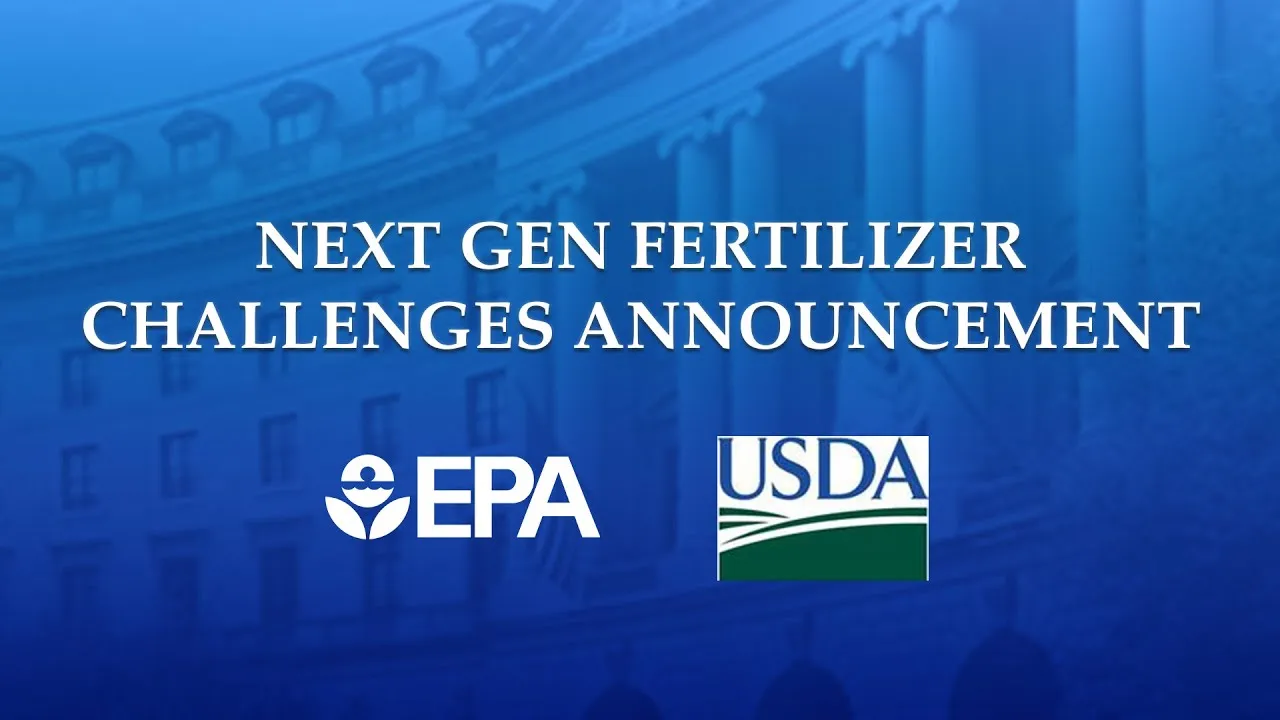


USDA e EPA anunciam vencedores do Next Gen Fertilizer Innovations Challenge
WASHINGTON, 19 de outubro de 2021 - Hoje, o Departamento de Agricultura dos EUA e a Agência de Proteção Ambiental dos EUA (EPA) anunciaram os vencedores do Next Gen Fertilizer Innovations Challenge, o segundo de uma parceria e competição conjunta USDA-EPA de duas partes sobre fertilizantes de eficiência aprimorada (EEFs) para promover a sustentabilidade agrícola nos Estados Unidos. O objetivo da competição é melhorar a eficiência dos fertilizantes para aumentar a produtividade das colheitas e, ao mesmo tempo, reduzir os impactos dos fertilizantes no meio ambiente.

Os vencedores do desafio enviaram conceitos para novas tecnologias que podem reduzir os efeitos ambientais do nitrogênio e do fósforo da agricultura moderna, mantendo ou aumentando a produtividade das colheitas. As soluções vencedoras usam nanopartículas que exigem menos fertilizantes e liberam nutrientes sob demanda para plantas em crescimento, e então se biodegradam em substâncias inofensivas ou mesmo nutrientes; suportam maior crescimento das plantas com a mesma ou menor aplicação de fertilizantes; e outras abordagens.
“Farmers, ranchers, and foresters are well-positioned to be leaders in tackling climate change through technological innovation,” said Acting USDA Chief Scientist Hubert Hamer. “Through programs like the Next Gen Fertilizer Innovations Challenge, USDA is partnering with the private sector to find new climate-smart solutions that are good for farmers and good for the environment.”
“The goal of the challenge is to develop and use innovative and affordable technologies to reduce environmental impacts of modern agriculture on our air, land, and water, while maintaining agricultural productivity and profitability,” said Wayne Cascio, acting principal deputy assistant administrator for science for EPA’s Office of Research and Development. “We are excited about the possibilities and continued new work in this area.”
The winning concepts include a range of solutions that can improve environmental outcomes, including reduced nitrous oxide emissions—the largest source of greenhouse gas emissions from agriculture— while maintaining or increasing crop yields.
Os vencedores incluem:
Soluções de nível 1 (prêmio de US$ 17.500):
Dr. Christopher Hendrickson, Aqua-Yield Operations LLC, Draper, Utah, por um fertilizante nanointeligente.
Taylor Pursell, Pursell Agri-Tech, Sylacauga, Ala., for “Urea 2.0,” which replaces the conventional urea core with a customizable mixture of materials to provide fertilizers tailored to local needs.
Soluções de nível 2 (prêmio de US$ 10.000):
Dr. Kuide Qin, Verdesian Life Sciences, Cary, NC, por usar tecnologias de mistura inovadoras para melhorar o desempenho da nitrapirina padrão da indústria para maior eficácia, menos lixiviação de nitrato e prevenção da corrosão de equipamentos agrícolas.
Dr. Catherine Roue, Fertinagro Biotech International, Portage, Mich., for “Phosphate Liberation Booster” technology, which uses secretions from phosphate-starved plants to boost plant uptake so less fertilizer may be added and legacy phosphorus can be accessed.
Chandrika Varadachari, Agtec Innovations Inc., Los Altos, Calif., for “Smart-N,” which is a smart-fertilizer that releases nutrients on-demand by the crop and which creates a chemical “cage” for urea that dissolves into plant nutrients.
Soluções de nível 3 (menção honrosa):
Dr. Jaroslav Nisler, do Instituto de Botânica Experimental, da Academia Tcheca de Ciências, República Tcheca, pelo uso de derivados do hormônio de crescimento vegetal MTU, que ajuda a criar períodos de crescimento mais longos, proteção contra estresse, plantas maiores e potencialmente menos perda de nutrientes por unidade de fertilizante aplicada.
Dr. Leanne Gilbertson, Civil and Environmental Engineering Department at the University of Pittsburgh, Penn., for creating a “protected fertilizer package,” which can carry nutrients through soil pores to the area around the plant roots.
Dr. Robert Neidermyer, Holganix LLC, Aston, Penn., for “Bio 800+,” a microbial inoculant that harnesses the power of over 800 species of soil microbes, kelp, and other soil amending ingredients to promote greater crop production and plant health.
Paul Mullins, Brandon Products Ltd., Ireland, for “BBS-1,” a biostimulant derived from seaweed extract that is applied as a fertilizer coating to improve nitrogen-uptake in root cells.
O USDA e a EPA estão coordenando os desafios do EEF com o Fertilizer Institute (TFI), o International Fertilizer Development Center (IFDC), a The Nature Conservancy (TNC) e a National Corn Growers Association (NCGA).
The competition launched on August 26, 2020. Part two of the first challenge, “EEFs: Environmental and Agronomic Challenge,” is ongoing. More information can be found at: www.epa.gov/innovation/next-gen-fertilizer-challenges.
USDA touches the lives of all Americans each day in so many positive ways. In the Biden-Harris Administration, USDA is transforming America’s food system with a greater focus on more resilient local and regional food production, fairer markets for all producers, ensuring access to safe, healthy and nutritious food in all communities, building new markets and streams of income for farmers and producers using climate smart food and forestry practices, making historic investments in infrastructure and clean energy capabilities in rural America, and committing to equity across the Department by removing systemic barriers and building a workforce more representative of America. To learn more, visit www.usda.gov.
-
Zinc Chloride: a reliable stabilizer for ice dye color salts in the dye industryNotíciasAug.11,2025
-
Propargyl Alcohol: A Multifunctional Chemical Additive in the Industrial FieldNotíciasAug.11,2025
-
Phosphorus Pentasulfide: a special material that combines moisture absorption and basic chemical valueNotíciasAug.11,2025
-
Natural Pesticides: The Environmental Choice for Green Prevention and ControlNotíciasAug.11,2025
-
Grass Pesticide: the invisible guardian of green lawnsNotíciasAug.11,2025
-
Dimethyl Sulfoxide: Key Assistance in Sample Management and Drug ScreeningNotíciasAug.11,2025
-
Uncover the Benefits of Sodium ChlorateNotíciasJun.24,2025


















